King Candy works blue on "Conan."
The post What Does Donald Trump Talking About His Cock Sound Like in King Candy’s Voice? appeared first on Cartoon Brew.
Add a Comment
King Candy works blue on "Conan."
The post What Does Donald Trump Talking About His Cock Sound Like in King Candy’s Voice? appeared first on Cartoon Brew.
Add a Comment
Coming March 2018.
The post Disney Officially Announces ‘Wreck-It Ralph’ Sequel appeared first on Cartoon Brew.
Add a CommentDyke Robinson alleges that Disney infringed his copyright for a project called "Digiland."
Add a CommentIn 2013, filmgoers in the United Kingdom and Ireland watched more animation than any other type of film, according to a new report by the British Film Institute.
Add a Comment

Cory Loftis works as a visual development artist at Walt Disney Animation and has contributed his efforts to films such as Wreck-it Ralph. Below are two doughnuts that Cory during the production of that film.


Below is one of many pieces of development artwork that Cory created for Carbine Studios’s new game, Wildstar. He featured more of his work from that game in this blog post.

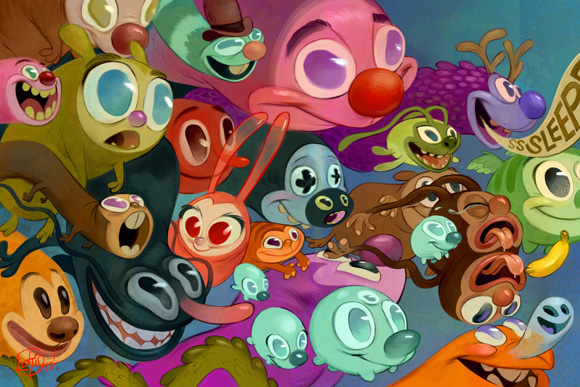
Cory primarily draws and paints digitally, and prolifically produces personal work which he shares on his Tumblr and blog.
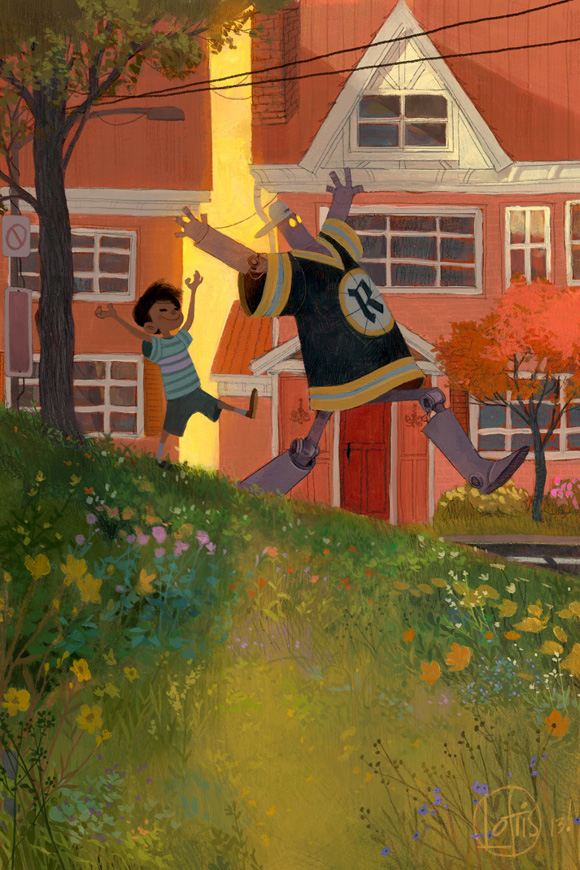
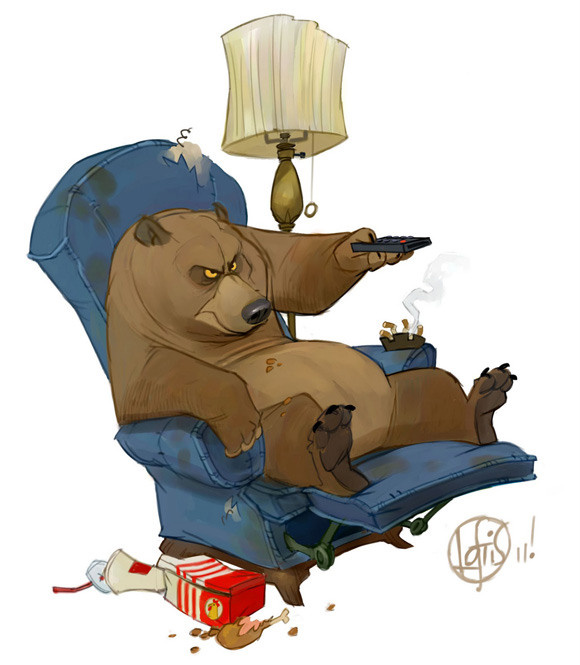


Whether it be for lack of budget or a desire to take center stage, series creators lending their own voices to their animated television shows has always been fairly commonplace – Mike Judge (Beavis and Butthead, King of the Hill), John Kricfalusi (Ren and Stimpy), Seth MacFarlane (Family Guy) and Trey Parker and Matt Stone (South Park) immediately spring to mind. However, in recent years, more and more feature directors have started getting in on the trend. From throwaway one-liners to continuous roles throughout entire franchises, here is a list of some animation directors and the characters they brought to life in their own films.
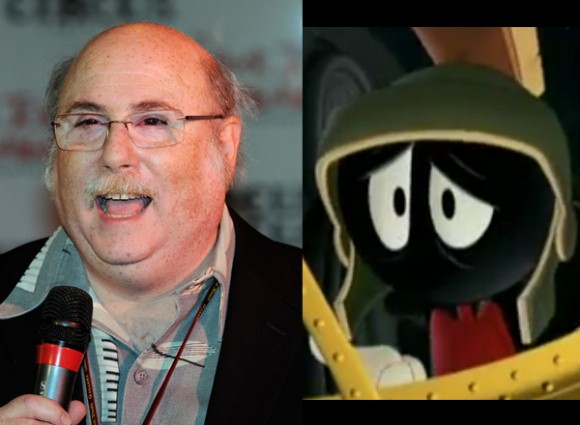 As the animation director for Looney Tunes: Back in Action (2003), Goldberg not only supervised the animation of the WB’s classic characters but he voiced some of them as well. Goldberg recorded the dialogue of Marvin the Martian, Tweety Bird and Speedy Gonzalez.
As the animation director for Looney Tunes: Back in Action (2003), Goldberg not only supervised the animation of the WB’s classic characters but he voiced some of them as well. Goldberg recorded the dialogue of Marvin the Martian, Tweety Bird and Speedy Gonzalez.
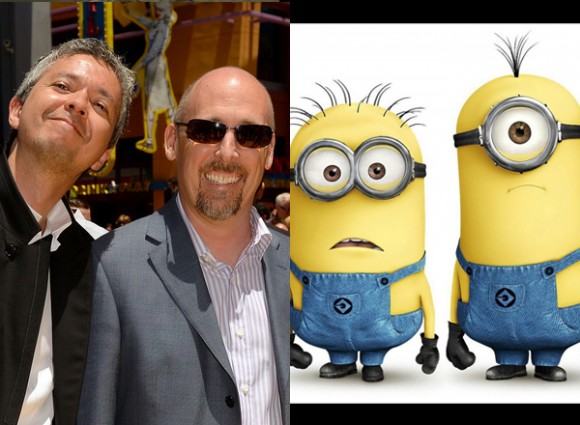 The distinctive sputters, spurts and high-speed mutterings of The Minions in Despicable Me (2010) and Despicable Me 2 (2013) belong to the films’ co-directors Pierre Coffin (above left) and Chris Renaud. And as the character’s popularity grows, so does their vocal commitment, as the two will reprise their roles in next year’s prequel Minions.
The distinctive sputters, spurts and high-speed mutterings of The Minions in Despicable Me (2010) and Despicable Me 2 (2013) belong to the films’ co-directors Pierre Coffin (above left) and Chris Renaud. And as the character’s popularity grows, so does their vocal commitment, as the two will reprise their roles in next year’s prequel Minions.
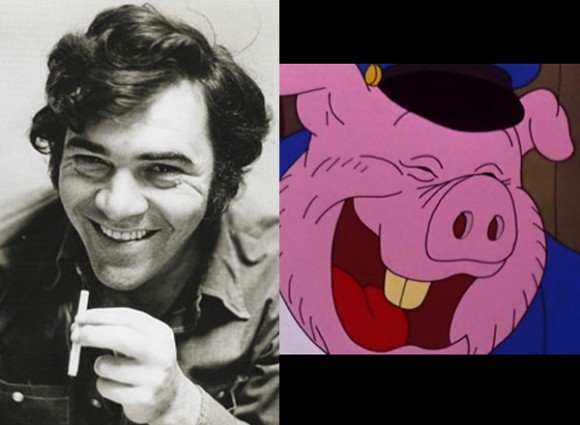 In his debut film Fritz the Cat (1972), director Ralph Bakshi voiced one of the boorish antagonist Pig Cops, who is also referred to as “Ralph” multiple times in his scenes.
In his debut film Fritz the Cat (1972), director Ralph Bakshi voiced one of the boorish antagonist Pig Cops, who is also referred to as “Ralph” multiple times in his scenes.
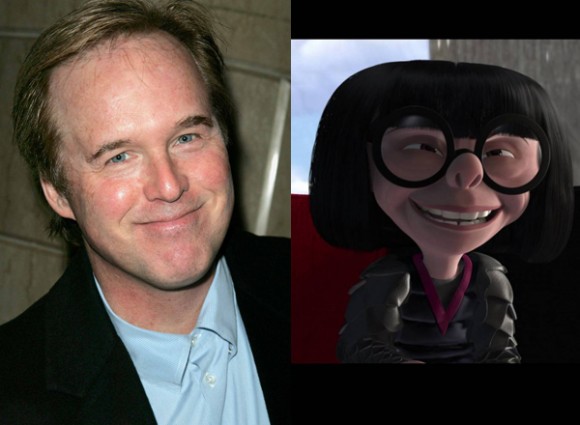 Agnes Gooch, Edith Head, Patricia Highsmith, Linda Hunt – when it comes to figuring out who inspired the character of Edna Mode, people love to toss out many names, but in the end, the cutthroat designer of superhero fashion was brought to life by The Incredibles (2004) director Brad Bird.
Agnes Gooch, Edith Head, Patricia Highsmith, Linda Hunt – when it comes to figuring out who inspired the character of Edna Mode, people love to toss out many names, but in the end, the cutthroat designer of superhero fashion was brought to life by The Incredibles (2004) director Brad Bird.
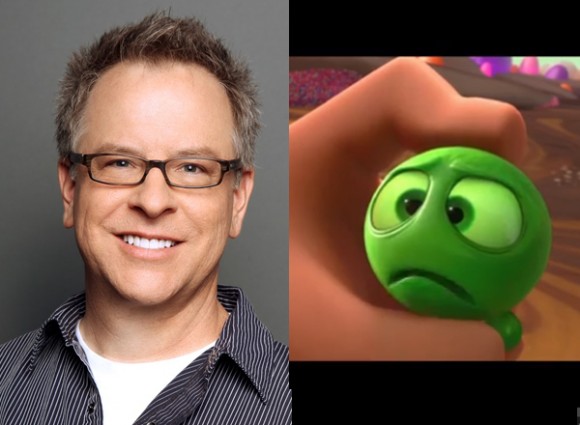 Rich Moore, director of Wreck-It Ralph (2012) provided the dreary monotone of acidic jawbreaker Sour Bill, the henchman to the bombastic King Candy.
Rich Moore, director of Wreck-It Ralph (2012) provided the dreary monotone of acidic jawbreaker Sour Bill, the henchman to the bombastic King Candy.
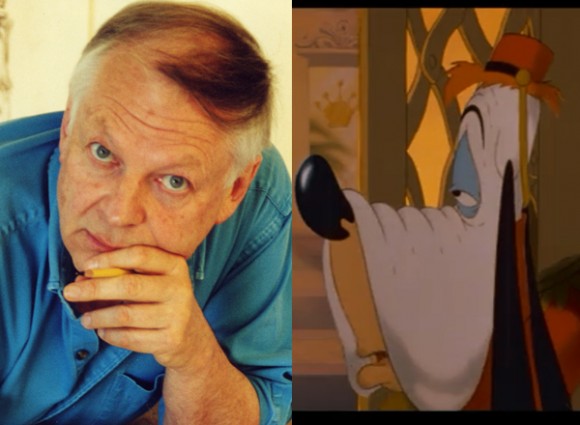 Even to this day, the toon celebrity cameos in Who Framed Roger Rabbit(1988) remain some of the best nods to the golden age of cartoons, especially that of Droopy Dog, who gets his opportunity to best Eddie Valiant with some traditional ‘toon high-jinks as a tricky elevator operator, sluggishly voiced by the film’s animation director Richard Williams.
Even to this day, the toon celebrity cameos in Who Framed Roger Rabbit(1988) remain some of the best nods to the golden age of cartoons, especially that of Droopy Dog, who gets his opportunity to best Eddie Valiant with some traditional ‘toon high-jinks as a tricky elevator operator, sluggishly voiced by the film’s animation director Richard Williams.
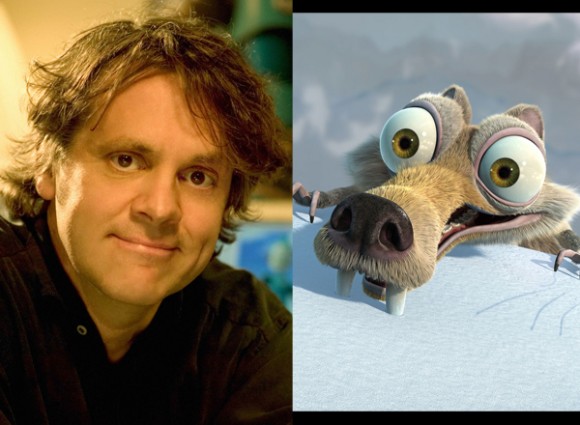 What began as the high-strung snivels and snarls of Scrat in Ice Age (2002) has become a second career for director Chris Wedge who has gone on to vocally personify the prehistoric rodent in 3 sequels, 6 short films, 2 video games and in a walk-on role in an episode of Family Guy.
What began as the high-strung snivels and snarls of Scrat in Ice Age (2002) has become a second career for director Chris Wedge who has gone on to vocally personify the prehistoric rodent in 3 sequels, 6 short films, 2 video games and in a walk-on role in an episode of Family Guy.
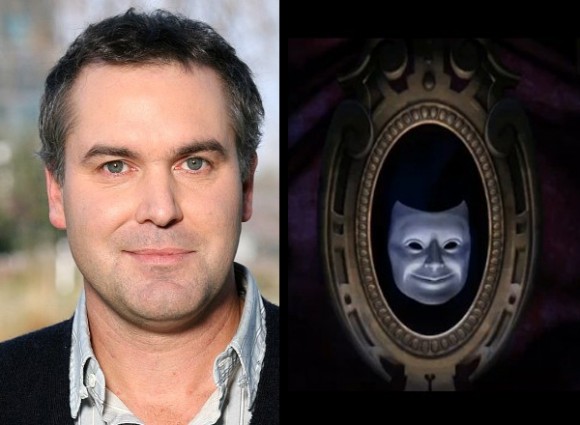 Royal messengers, tower guards, army commanders, friars and penguins, story artist Chris Miller has lent his voice-over skills to numerous animated films, most notably his returning roles as Geppetto and The Magic Mirror in the Shrek franchise, including Shrek the Third (2007), which he co-directed.
Royal messengers, tower guards, army commanders, friars and penguins, story artist Chris Miller has lent his voice-over skills to numerous animated films, most notably his returning roles as Geppetto and The Magic Mirror in the Shrek franchise, including Shrek the Third (2007), which he co-directed.
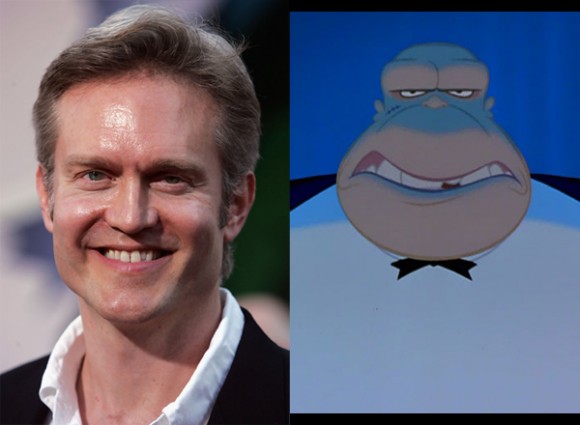 The often ignored and underrated animated film Cats Don’t Dance (1997) features some beautiful hand-drawn work and stellar vocal performances, including that of director Mark Dindal as the tight-lipped bodyguard/butler Max.
The often ignored and underrated animated film Cats Don’t Dance (1997) features some beautiful hand-drawn work and stellar vocal performances, including that of director Mark Dindal as the tight-lipped bodyguard/butler Max.
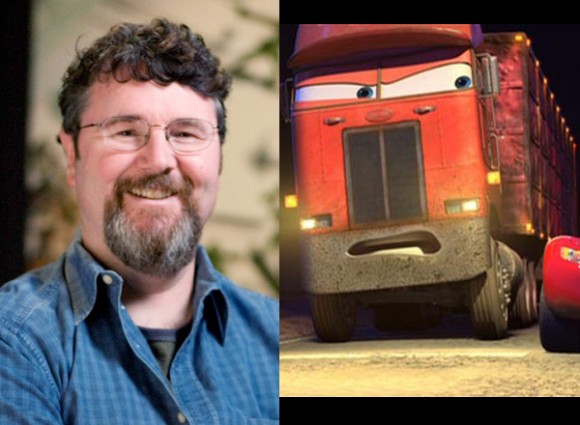 Pixar story artist, the late Joe Ranft, brought a handful of memorable animated characters to life, including Heimlich (A Bug’s Life), Wheezy the Penguin (Toy Story 2) and Jacques the Cleaner Shrimp (Finding Nemo). But it was in Cars (2006), which he co-directed, that he voiced three characters including the semi-truck Jerry Recycled Batteries.
Pixar story artist, the late Joe Ranft, brought a handful of memorable animated characters to life, including Heimlich (A Bug’s Life), Wheezy the Penguin (Toy Story 2) and Jacques the Cleaner Shrimp (Finding Nemo). But it was in Cars (2006), which he co-directed, that he voiced three characters including the semi-truck Jerry Recycled Batteries.
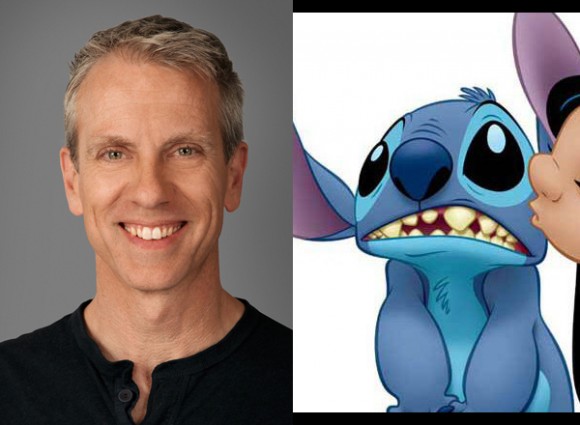 In Lilo & Stitch (2002) co-director Chris Sanders takes on the nuanced role of Alien Experiment 626, aka “Stitch,” who escapes from an intergalactic prison only to find himself trapped on the Hawaiian island of Kauai.
In Lilo & Stitch (2002) co-director Chris Sanders takes on the nuanced role of Alien Experiment 626, aka “Stitch,” who escapes from an intergalactic prison only to find himself trapped on the Hawaiian island of Kauai.
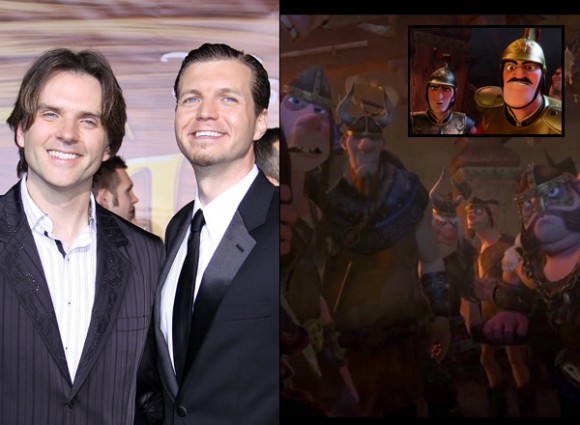 Nathan Greno (above right) and Byron Howard not only paired up as co-directors of Tangled (2010) but also doubled as duos of Thugs and Guards in the animated picture.
Nathan Greno (above right) and Byron Howard not only paired up as co-directors of Tangled (2010) but also doubled as duos of Thugs and Guards in the animated picture.
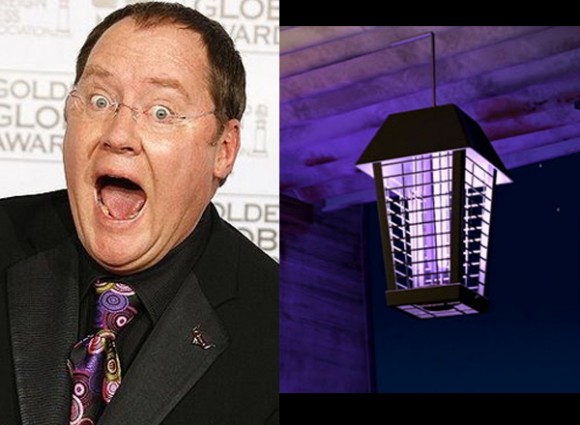 With five features under his belt, John Lasseter has had plenty of opportunity to throw himself behind the microphone, however upon review of his filmography, you’ll find he has chosen his roles very carefully, as the role of John Lassetire in Cars 2 (2011) and the hilariously bug-zapped Harry the Mosquito in A Bug’s Life (1998).
With five features under his belt, John Lasseter has had plenty of opportunity to throw himself behind the microphone, however upon review of his filmography, you’ll find he has chosen his roles very carefully, as the role of John Lassetire in Cars 2 (2011) and the hilariously bug-zapped Harry the Mosquito in A Bug’s Life (1998).

Ryan Lang works as a visual development artist at Walt Disney Animation, including on the upcoming Disney/Marvel pic Big Hero 6.
Ryan did extensive work on Wreck-It Ralph, and his concept art helped to realize the world and objects of the film, as seen in these examples:


Ryan shares some of his personal work and digital/traditional paint studies on his blog:



These menacing figures below won’t appear in a Disney film anytime soon, but they show his range as an artist:


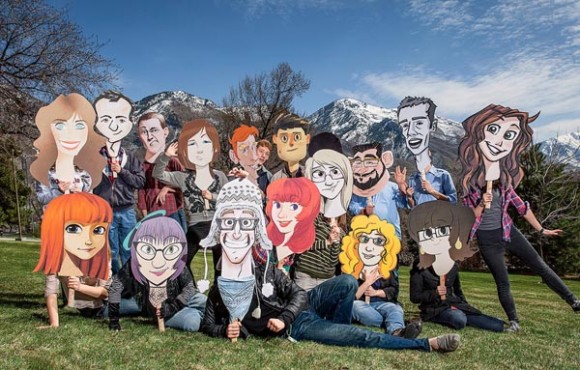
Last weekend, the New York Times Sunday Magazine published a proile of the computer animation program at Brigham Young University. The school has gained a reputation in the last decade for its student films which are typically produced as group projects by the entire class, and thus exhibit high production values. (Some of these films have been featured on Cartoon Brew in the past.)
The focus of the article is the creative tension that exists between the students who attend the school and their Hollywood aspirations because Brigham Young is a Mormon-owned university run by the Church of Jesus Christ of Latter-day Saints:
Students must regularly attend church services. No sex outside of marriage. (“Live a chaste and virtuous life.”) No alcohol or coffee. (There aren’t even caffeinated sodas in the vending machines.) No swearing. No deviations from the university’s meticulous grooming standards. (“If a yearly beard exception is granted, a new Student ID will be issued after the beard has been fully grown and must be renewed every year by repeating the process.”)
The director of B.Y.U.’s animation program, R. Brent Adams, says that the students who come out of the program have a different approach to filmmaking and life in general than the average fresh-out-of-school film industry pro: “Without being preachy about it, if we can add something to the culture that makes people think about being better human beings—more productive, more kind, more forgiving—that’s what we want to do.”
Curiously, the write-up mentions praise for the school from Disney Animation and Pixar president Ed Catmull, the highest-profile Mormon working in animation, but neglects to mention that he is a Mormon, too. The films that Catmull oversees, such as Wreck-It Ralph, get an ethical pass from at least one student interviewed for the piece:
Add a CommentIt wasn’t simply a matter of avoiding sex and violence. (A few times, I heard even Shrek described disapprovingly: too many fart jokes, too much cynicism.) There was, instead, a fixation on whether you walked away from the movie feeling uplifted. That question superseded everything, even the usual genre and age-demographic lines. A senior, Megan Lloyd, told me: “I just saw The Dark Knight. It was wonderful, but it’s just so dark. I didn’t feel better about myself after I saw it. Instead, I felt like, I’m a horrible human being—like all human beings are. Now,” she went on, nearly in the same breath, “contrast that with a film like Wreck-It Ralph. That teaches you: Hey, you can be a better person. Here’s how!”
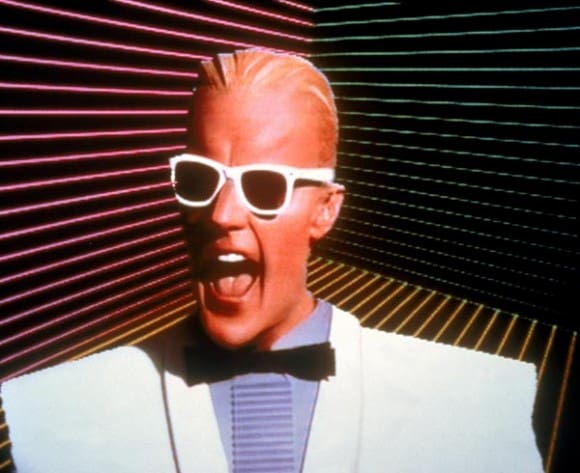
I’ve come across people who believe that Max Headroom, the Channel 4 character from the Eighties, was a genuine piece of computer animation. But although he was conceived by the animators Rocky Morton and Annabel Jankel (of Cucumber Films fame) Max himself was portrayed by actor Matt Frewer, placed into latex makeup and a shiny costume and set amidst a strange of technological tricks.
Half of the frames from the footage used in Max Headroom were removed in production, resulting in a juddery look to suggest animation shot on twos, and Frewer was bluescreened in front of a basic digital backdrop. The crew even added deliberate faults to the “animation” – such as the stammer which became Max’s trademark – to complete the effect.
This process seems somewhat surreal today, in our brave new world of Maya, Xtranormal and Blender. Max Headroom was created at a time when 3D CGI animation was desirable, but not always affordable; if the budget did not allow it, then the crew had to fake computer animation in front of the camera.
Another good example of this can be found in the 1981 film Escape from New York. Early on in the movie we see what appears to be a wireframe model of Manhattan; in actual fact, a physical model was built for this sequence, with reflective tape placed along the edges of the buildings. Shot under ultraviolet light, this recreated the luminescent green-on-black effect of primitive CGI.
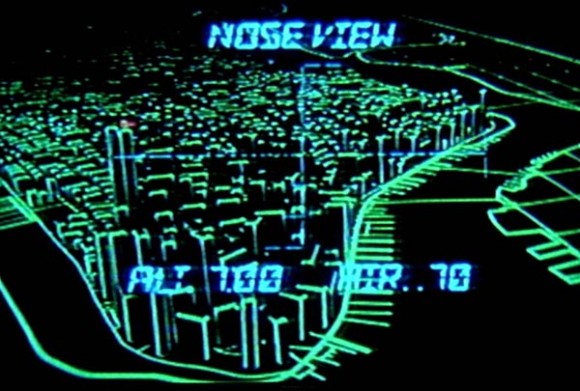
There has even been an incident in which a budget imitation of CGI itself received a budget imitation. In 1987 an unidentified signal hacker managed to replace two television broadcasts with a mildly disturbing video of a home-made Max Headroom show. In this improvised effort Max was portrayed by a man in a shop-bought mask, while the moving backdrops – in the original series, an example of genuine digital animation amongst the pseudo-CGI – were replaced with somebody offscreen wiggling a bit of corrugated metal about.
These are all extreme examples; during this period, it was more common for digital animation to be emulated using hand-drawn techniques. Often used as a visual motif in kids’ science fiction-themed cartoons (witness the cel animated wireframes in the opening sequence to Transformers) this approach was put to good use by Rod Lord‘s animation work on the Hitchhiker’s Guide to the Galaxy television series from 1981. Created using litho film and coloured gels, these sequences suggested digital graphics simply by combining glowing primarily-coloured images with a black background. An added plus was that the animation could get away with being a little bit jerky…
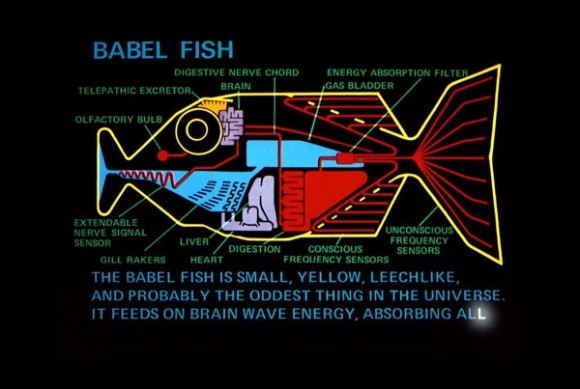
One sequence in Hitchhiker’s Guide portrayed an intergalactic war as an early video game, a theme drawn upon by other animators: for example, in 1982 a British public information film used Space Invaders-like imagery to advise audiences on safe driving [see image below]. The biggest example of this, however, came when Disney produced an entire feature film based around the look of eighties arcade games: Tron.
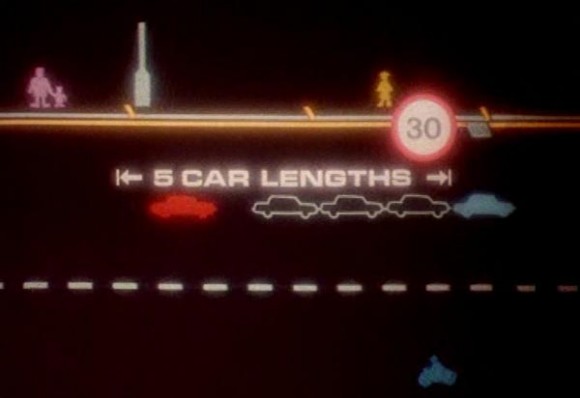
Tron contained genuine CGI animation backed up with large amounts of compositing tricks based around matte effects and backlighting; this made the live action footage look as though it had been digitally processed. As a result, the film stands as arguably the premiere example of pseudo-CGI.
In her book British Animation: The Channel 4 Factor Clare Kitson remarked on the fact that Max Headroom, Channel 4’s biggest animated hit, was not actually animated. But as she went on to argue, perhaps it is time for a reappraisal:
I wonder if we might indeed classify those sequences as animation nowadays. With the plethora of different technologies now employed, the previous narrow definition (which insisted that the movement itself must be created by the animator) seems a bit old-fashioned. These days anything that appears on a screen and moves but is not a record of real life – including creatures moved by motion capture – tends to fall under the animation umbrella… The current popular synonym for animation, ‘manipulated moving image’, seems to be made for Max.
Of course, if Max had been made using actual CGI he would have ended up as a creaky old relic, rather like the “Money for Nothing” video which came out the year after his debut. Instead, Jankel, Morton and Frewer came up with a genuinely iconic creation that has aged surprisingly well.
Today, it is all too easy for animators to fall back on the tricks of their software and lose track of the wider aesthetic potential of their work. What Max Headroom—and, to an extent, some of the other pieces mentioned here—show is the opposite effect: digital animation spurring creativity in analogue work. They have an ingenuity and hand-made charm which is missing from so much modern computer animation.
Primitive digital imagery has had something of a resurgence across the past decade or so, to the point where pastiches of 8-bit pixel graphics have found their way into mainstream productions such as Wreck-It Ralph. Perhaps it is time that the animators and digital artists of today rediscovered the lesser-known cousin of this aesthetic: the strange world of pseudo-CGI.
NEIL EMMETT is the editor of The Lost Continent, a fantastic resource devoted to British animation, past and present. This piece is an expanded version of a post that originally appeared on his site.
Add a Comment
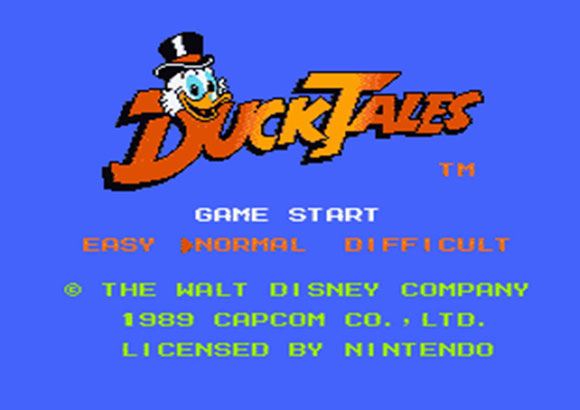 The line between animation and video games has long been blurred. There was the Saturday Supercade on CBS in the mid-80s, where Frogger, Q-Bert and Donkey Kong starred in short segments. A handful of years later, Fox ran the Super Mario Bros. Super Show! and NBC had Captain N: The Game Master. All of these shows were relatively short-lived marketing methods of pushing Nintendo further into homes and the minds of children. But lately, the animation and video game industries have united under the banner of nostalgia, appealing to adults whose childhoods were spent chasing down the aproned token keeper in the local arcade.
The line between animation and video games has long been blurred. There was the Saturday Supercade on CBS in the mid-80s, where Frogger, Q-Bert and Donkey Kong starred in short segments. A handful of years later, Fox ran the Super Mario Bros. Super Show! and NBC had Captain N: The Game Master. All of these shows were relatively short-lived marketing methods of pushing Nintendo further into homes and the minds of children. But lately, the animation and video game industries have united under the banner of nostalgia, appealing to adults whose childhoods were spent chasing down the aproned token keeper in the local arcade.
This nostalgic trip is partly due to a major shift in demographics. Generation X and Y, the first to experience video game-filled childhoods, have grown up, and many of them now have young children of their own. It explains the broad appeal of Wreck-It Ralph—a father who spent countless hours feeding quarters to a PacMan arcade game was just as likely to be entertained by the film as his child. In fact, Disney succeeded in creating faux arcade games that felt so real, adult audience members were convinced to the point of feeling nostalgic. Fix It Felix Jr., the game in which Ralph was the villain, felt ripped from your childhood arcade.
You could assume this nostalgia trend would’ve peaked with Wreck-It Ralph, but it shows no signs of slowing. Ratchet & Clank, the series of Playstation games initially released in 2002, is finally receiving the animated film adaptation that its fans have craved. Rainmaker Entertainment and Blockade Entertainment plan to produce the film for a theatrical release in 2015. Fortunately, the fan base has grown right along the game. Says one commenter on The Nerdist : “The twelve year old in me (currently 23) just stood up and yelled, ‘Finally!’”
Then there’s game developer WayForward, set to release a remastered version of DuckTales, Capcom’s hit that originally sold nearly 3 million copies on NES and Game Boy. It was and is exceedingly popular, with gamers still raving about the game’s tight handling. Among 8-bit musicians, who derive their tunes from the sounds of Nintendo, the DuckTales soundtrack is a unanimous favorite. Some even say that the Nintendo game eclipses all other aspects of the DuckTales franchise, including the animated series.
What’s most incredible about this project from WayForward is its unabashed pandering to a nostalgic audience. WayForward’s remastering remains true to the original, with whole levels of the game completely duplicated, save for enhanced background graphics. According to an article on the Verge, Disney even went so far as to provide original art assets and the voice actors from the DuckTales animated series, including 90-year-old Alan Young as Scrooge. “We’re really trying to make it play as identical to the original as possible,” says WayForward’s Austin Ivansmith. “We thought, well if the original developers could make this again today, what would they do?”
There is no doubt that DuckTales was a major keystone of early video game history—I even revisit my own copy once every few years. Young parents who grew up playing DuckTales on NES will leap at the chance to reintroduce the game to their kids on the contemporary consoles of today. These sorts of modern reinterpretations can certainly yield some fresh, artistic perspective. But the relationship between the animation and video game industries is becoming more blatantly based on the desire for financial sure-bets. And if we know anything about Hollywood, where movies based on boardgames are greenlit, audiences will continue to be encouraged to wallow in childhood nostalgia.
Add a Comment
The first part of the 8-bit styled end credits for Wreck-It Ralph has now been post online. In a film filled with clever bits, gags and visuals, this was a nice way to top it off…
Add a Comment
The LA Times conducted an hour-loung roundtable with the directors of five recent animated features: Mark Andrews (Brave), Peter Ramsey (Rise of the Guardians), Chris Butler (ParaNorman), Rich Moore (Wreck-It Ralph) and Genndy Tartakovsky (Hotel Transylvania).
Add a Comment
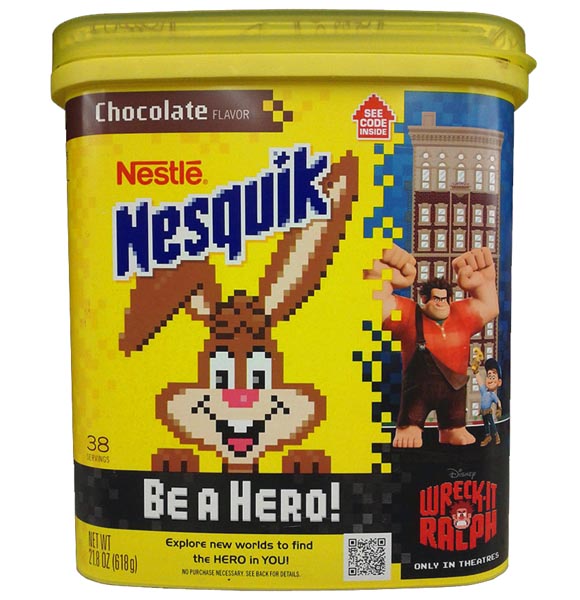
In Disney’s Wreck-It Ralph, Nesquik nearly kills two of the film’s main characters. Well, they weren’t joking about the deadly nature of the sugary drink. Wreck-It Ralph-themed Nesquik can also kill you in real life.
Nestle USA is recalling 200,000 cans of Nesquik Chocolate Powder due to possible salmonella contamination, which can be life-threatening to infants, pregnant women, the elderly and individuals with weakened immune systems. The recall affects 10.9, 21.8 and 40.7-ounce canisters with a “best if sold by” date of October 2014.
Add a Comment
Wreck-It Ralph director Rich Moore is conducting a Reddit AMA today and he had a rather pointed answer to the question, “What concerns did you have going into production of the film? Was there anything in particular you were worried about?” Moore’s response: “Dreamworks stealing the idea, slapping it together and getting it out first.”
(h/t, Jonah)
Add a Comment
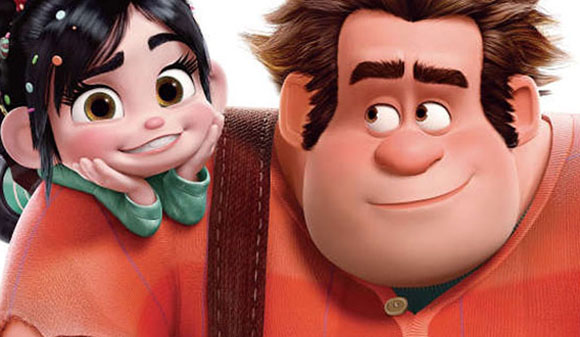
Wreck-It Ralph was the box office champion this weekend with an estimated $49.1 million U.S. box office gross. This is reportedly the highest opening weekend ever for a Disney animated feature film. According to Box Office Mojo:
The movie’s audience skewed younger (57 percent under the age of 25) and male (55 percent), and they gave it a strong “A” CinemaScore. Considering the positive word-of-mouth and lack of competition over the next few weeks, Wreck-It Ralph could be on its way to as much as $200 million at the domestic box office.
Ralph took in almost double that of it’s nearest competitor – Robert Zemeckis’ Flight, which grossed about $25 million. Sony’s Hotel Transylvania has held on very well, with $4.5 million added this weekend to its total $137 million gross (so far). Frankenweenie is sinking fast, it’s total gross thus far at $33.3 million.
Add a Comment
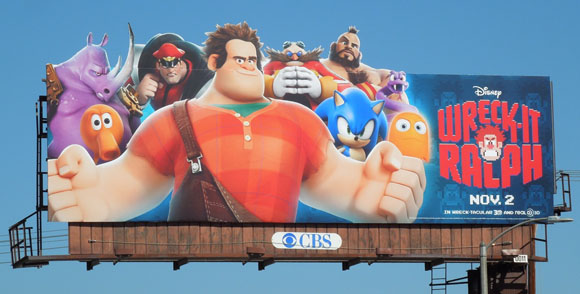
After several months of monster/horror animated features, it feels down-right refreshing to see a simply funny new “cartoon” from Disney. Wreck-It Ralph (along with the innovative cg/hand drawn hybrid short Paperman) opens today – and just in time.
I dare say, between Tangled and Ralph, the Disney Feature team has found their footing – and personally I was much more satisfied with this high-concept comedy than I was with Pixar’s most-recent original. Could this be the year Disney’s SoCal home-team beats its upstate sibling? Wreck-It Ralph is executed with as much entertainment and humor, visually and verbally – and a healthy dose of “Disney magic” – as one could expect. It has an obvious appeal to adults, and even more so to kids, which bodes well for its box office results.
I’m not the only one to feel this way. A.O. Scott in The New York Times calls Ralph a big “success”, managing “to be touching as well as silly, thrilling and just a bit exhausting”. Betsy Sharky in The Los Angeles Times says, “the movie’s subversive sensibility and old-school/new-school feel are a total kick”.
“Old-school/new-school” might also describe John Kahrs sublime new short Paperman, which is attached to all showings of Wreck-It Ralph. We’ve been anticipating this short for several months and it plays like icing on the cake. A sumptuous boy-meets-girl story told in an exciting new/retro way – crossing my fingers this begins a transition back to the hand drawn craft of animation, in the classic Disney tradition, at the Disney studio.
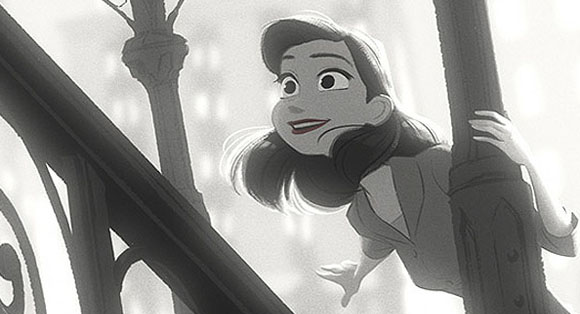
So, what about you? If you’ve seen Wreck-It Ralph and/or Paperman, let’s have the discussion. Tell us your thoughts in the comments section below.
Add a Comment

To recap: this season has already brought two must-have books – J.B. Kaufman’s Snow White history, The Fairest One Of All and Charles Solomon’s lavishly illustrated survey of Charlie Brown animation, The Art and Making of Peanuts Animation. But the season isn’t over and here are four more highly recommended hardcovers worth every cent of their suggested retail price.
First up, “I Say, I Say… Son! A Tribute To legendary Animators Bob, Chuck and Tom McKimson by Roberet McKimson Jr., with a forward by John Kricfalusi and an introduction by Darrell Van Citters. Wow! This is a surprise and a real treat. Poor Robert McKimson never got the attention and adoration his fellow directors Chuck Jones and Friz Freleng did. Thankfully, his champions have created this celebration of of all things McKimson – and that includes the incredible contributions of his siblings, Charles and Tom, who all together contributed more to the look and feel of Looney Tunes and Merrie Melodies than almost anyone else.
Robert McKimson’s son has put together a delicious volume of art and history that’s way overdue. John K. starts it off with a great seven-page Foreword explaining his admiration for the McKimson brothers work (images in this section include an original John K. drawing of Foghorn Leghorn meeting Stimpy!); and Darrel Van Citters does likewise in his informative intro. The meat of the book is the incredible art and photos that follow from the McKimson family estate. Bob Jr’s text takes us from his fathers earliest experiences at Disney and the Romer Grey studio to the earliest days at Harman-Ising. Absolutely gorgeous pencil art of Bosko (from Schlesinger) and Binko (from Romer Grey) highlight this section. Rare paintings, staff photos, the U.S. copyright registration for Bugs Bunny (!), model sheets, layout sketches, coloring book art… incredible stuff. A chapter on Tom McKimson’s work at Western Publishing and Bob’s later career at UPA, DePatie Freleng and back at Warners in 1969 tie up any and all loose ends. A thorough, competent, visually delightful job – exactly what you’d expect from someone named McKimson. Bravo, I love it!
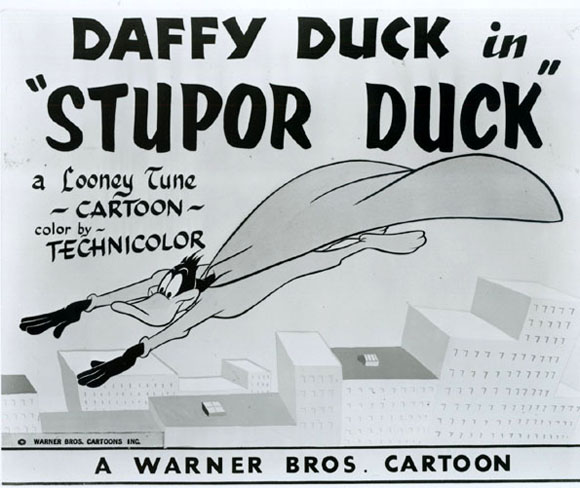
Next we have: Walt Disney’s Mickey Mouse Vol. 4: “House Of The Seven Haunts!” edited by David Gerstein and Gary Groth.
What can I say? Gerstein and Groth do it again. For the 4th time, Floyd Gottfredson’s incredible (and incredibly rare) 1930s Mickey Mouse adventure strip is collected with much care and great thought. The fact these were never reprinted before is criminal – the way they have been presented here more than makes up for it. The comics strips are compiled from the highest quality reprint masters and the daily strips themselves are truly classic material – worthy of a more prominent place in the Disney canon. As usual, Gerstein’s “bonus materials” – the liner notes, essays and special features – that appear at the beginning and end of the book represent Disney scholarship at its highest level.
This time Gerstein (along with colleagues Tom Andrae, Carson Van Osten and Thad Komorowski) provide insight into Minnie Mouse, Donald Duck, Goofy and such supporting players as Oscar the Ostrich and Dr. Einmug, rare artwork from international merchandise, publicity images and lost storyboards from from the Disney Animation Research Library. This series is a keeper. If you’ve got the first three volumes, you know the score. If not, maybe this video (below) will convince you. It’s terrific!
Imagination Illustrated: The Jim Henson Journal by Karen Falk, is not devoted to animation (though Muppet Babies is given a nice spread), but Henson’s Muppet legacy – and that cannot be ignored. Henson’s films, shows and all-over creativity are an inspiration to all who create frame-by-frame cartoons and this book is an incredible peek inside his mind. This book is based around Henson’s personal handwritten journal and materials from his archives – a scrapbook of Muppet history that I’m grateful the family has deemed to share. Beyond the Muppets, the book contains rare memorabilia and information on Henson’s experimental shorts and TV specials (some of which I’d never heard of), TV pilots, The Dark Crystal and Labyrinth, commercials and industrial shorts – everything he did is noted one way or another with rare photos, script pages, publicity photos and other incredible ephemera. If you like Muppets or have any interest in Henson, it’s a must. Get it.

Last but not least: The Art of Wreck-It Ralph by Maggie Malone and Jennifer Lee.
Usually I recommend these “Art of” books because – let’s face it – even if the movie is no-good, the pre-vis and character designs are usually fantastic. Wreck-It Ralph is not only a great little film, but the artwork is especially fun. Director Rich Moore assembled a hand-picked crew of cartoonists to inspire the look of the film and they did not fail. No wonder the stuff on the screen looks so good – the preliminary art pictured here shows he had a lot of quality to choose from. Mike Gabriel, Jin Kim, Bill Schwab, Lorelay Bove, Glen Keane, and Minkyu Lee are just a few of the artists supplying the eye candy here, providing the appropriate “sugar rush” you require. This is a good one.
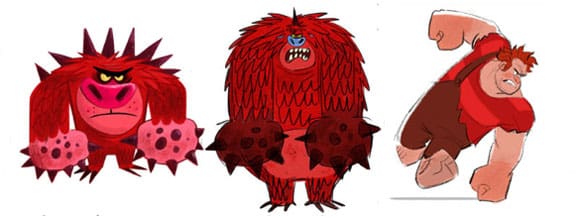
I actually like the U.S. trailer we posted a month ago a little better than this one. Here’s the latest version, created for international release, featuring a few more shots they haven’t shown before.
Add a Comment
After several months of ghosts, ghouls and creatures of the night… Disney’s Wreck-It Ralph is looking like a breath of fresh air – in more ways than one. This looks like fun:
Add a Comment
Two things we never imagined together courtesy of artist Jeaux Janovsky: Disney’s upcoming film Wreck-It Ralph and Ralph Bakshi make…
Click to enlarge, or go here for more Bakshi.
Cartoon Brew |
Permalink |
No comment |
Post tags: Ralph Bakshi, Wreck-it Ralph
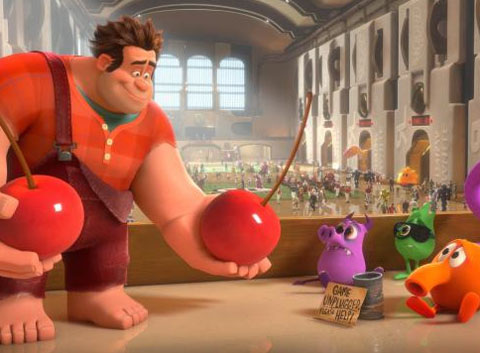
This week we are getting our first look at Disney’s next animated feature, Wreck-It Ralph. USA Today got the exclusive first pics from Rich Moore’s film – and the teaser trailer should be online tomorrow. I’m actually excited about this film, because from all indications it will be a big change from the traditional fairy tales and animal adventures Disney has been producing of late. The film re-teams director Moore (from The Simpsons and Futurama) with writer Jim Reardon (Simpsons, Tiny Toons, Bakshi’s Mighty Mouse… not to mention, Wall-E), bringing a new comic sensibility to the studio. Bring it on!
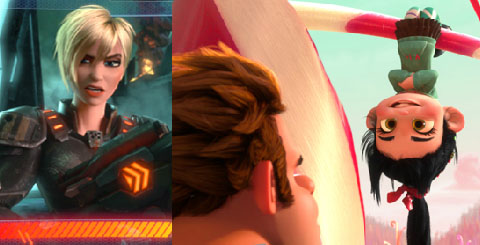
Cartoon Brew |
Permalink |
21 comments |
Post tags: Jim Reardon, Rich Moore, Wreck-it Ralph
My favorite publisher Chronicle Books just put out their Fall/Winter 2012 catalog and they’re releasing more animation and cartoon-related books this holiday season than ever before. Below are the six titles (including one by myself) that will be of interest to Cartoon Brew readers, followed by the catalog pages with images and descriptions of each book.
The Art and Making of ParaNorman by Jed Alger
August 2012, Pre-order for $21.74.
Sketchtravel by Gérald Guerlais and Dice Tsutsumi
September 2012, Pre-order for $23.52.
The Art of Wreck-It Ralph by Maggie Malone and Jennifer Lee Monn
November 2012, Pre-order for $21.74.
Imagination Illustrated: The Jim Henson Journal by Karen Falk
November 2012, Pre-order for $16.27.